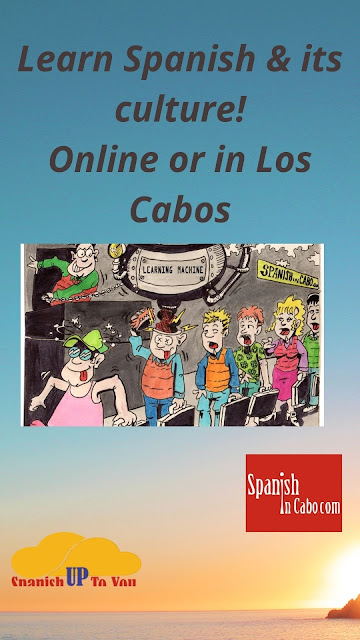“Chile en nogada: Flavors, history... and a touch of grammar!”/"Chile en nogada: Sabores, historia… ¡y un toque de gramática!" 5 minutos de español
 |
| Bella estudiante de español muestra su platillo |
How are you? Good morning, good afternoon or good evening
depending on where you are or what time you are listening to us.
Welcome to this Spanish podcast, we are in
September, patriotic month and in podcast number 212, what is the theme for
this Wednesday?
We know that in this podcast learning is mixed with flavor
and culture, so we are going to talk about a typical Mexican dish that tastes
like history, can you guess what it is?
I'm
already hungry just thinking about it. Today we are going to talk about the
famous... chile en nogada! A typical dish from Puebla that has a very
interesting history... and delicious ingredients!
That's right, but before we talk about the recipe, let's
dive into the history of this dish. It turns out that chile en nogada was
created in 1821, right after Mexico's independence. It's a patriotic dish!
That's right! According to the story, the nuns
of the Santa Monica Convent in Puebla prepared this dish for Agustin de
Iturbide, who had proclaimed Mexico's independence. It was his birthday when he
arrived in Puebla, on August 28. What a coincidence, eh!
What a nice gift! Although, at first, Iturbide didn't want
to eat it because he had “stomach problems”... or so he said. Actually, some
say he was afraid of being poisoned. Can you imagine?
How dramatic! But when he saw such a colorful
and appetizing dish, he couldn't resist. And so the fame of chile en nogada was
born.
Of course, because
it is not only tasty, it is also very visual. The colors of the chile en nogada
represent the Mexican flag: green for the poblano chile, white for the nogada
sauce, and red for the pomegranate seeds.
Let's go to the vocabulary / Vamos al vocabulario
Monjas nuns
Emperador Emperor
Envenenado
poisoned
Nogada walnut
sauce
Granada pomegranate
Bandera flag
It's like eating Mexico's independence on a plate! Speaking of
independence... did you know that this dish is traditionally eaten in the
months of August and September? Just for the independence celebrations!
Yes, because that's when the ingredients are in season. Walnuts,
pomegranate... all fresh and delicious! And speaking of ingredients, let's
learn a little grammar. Let's practice with the verb “comer” in different
tenses.
Sure! Let's start with the present tense. If you're in Mexico in
September, you probably eat chile en nogada.
That's right. And now, back in the past, remember the story? Iturbide ate
chile en nogada for the first time in 1821.
And now, to the future. If you visit Mexico next year, you will eat this
dish.
Perfect. And you, Eduardo, if you were in Puebla right now, would you eat
chile en nogada?
Of course! I would eat it in a heartbeat! And well, if someone wants to
try it but is not in Mexico, you can always try to cook it at home. Just make
sure you have the right ingredients, because changing them can affect the
taste.
Totally! I know the recipe can be a little tricky though, but it's worth
it! And speaking of cooking, how about leaving a little question to ponder?
I love the idea! The question of the day is: Do you prefer to follow
traditional recipes step by step or do you like to innovate in the kitchen?
What would you do with a recipe as historic as chile en nogada?
We are waiting for your answer! Remember that you can write to us on our
social networks or leave us a voice message on WhatsApp group
Thank you very much for making it this far in the podcast. We hope you
enjoyed this tour through the history, flavor and grammar of chile en nogada.
We'll be hearing from you in the next 5-minute Spanish episode.
Goodbye and bon appetit!
Bye bye


Comentarios
Publicar un comentario